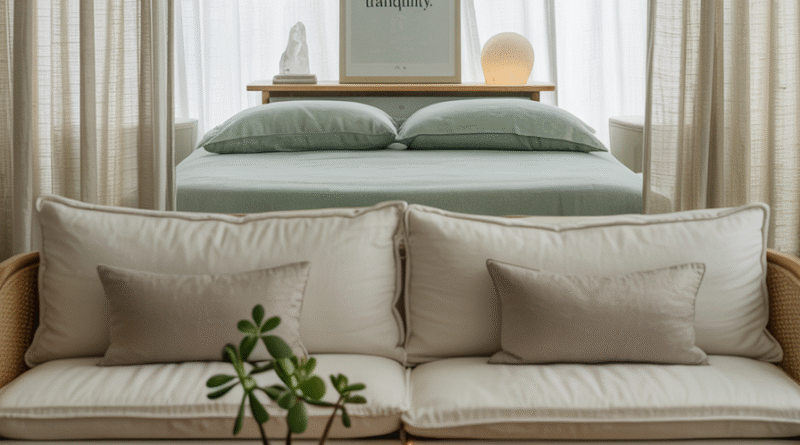How to Use Feng Shui to Balance the Energy in a Small Apartment
Living in a small space doesn’t mean you have to feel cramped, cluttered, or energetically blocked. With Feng Shui, even the tiniest apartment can become a sanctuary of flow, harmony, and support. The key lies in using intentional design to maximize Chi (life energy), balance the five elements, and create visual and energetic spaciousness.
Let’s explore how to use Feng Shui to harmonize and expand the energy in a small apartment.
1. Define Functional Zones, Even in Open Layouts
Small spaces benefit from clear energetic boundaries.
- Use rugs, lighting, or furniture arrangement to define separate areas: sleeping, working, eating, relaxing
- Avoid placing your bed or desk directly in line with the front door
- Let each zone have its own purpose and subtle decor shift
- If possible, face your key zones toward a window or open area to invite flow
Zoning creates clarity and reduces energetic chaos.
2. Use Mirrors to Expand Light and Space
Mirrors are powerful tools in small spaces.
- Place mirrors to reflect windows, greenery, or open spaces—not clutter or beds
- Avoid mirrors facing doors or directly across from each other (which can bounce energy too aggressively)
- Use framed, clean mirrors that feel intentional
- One large mirror is often better than many small ones
Mirrors move light—and light creates openness.
3. Keep Pathways Open and Unblocked
Flow is essential for good Feng Shui, especially where space is tight.
- Ensure doors open fully without hitting furniture
- Leave at least 40–60 cm of walkway space between key pieces (like bed and wall, or table and couch)
- Don’t store boxes or clutter in corners, under the bed, or behind doors
- Walk your apartment and observe where energy “catches” or stalls
Open space = open energy.
4. Prioritize Natural Light and Airflow
Chi flows best with light and air.
- Keep windows clean and unobstructed
- Open windows regularly to refresh the energy
- Use light, breathable curtains to soften glare without blocking brightness
- Add plants near windows to filter light and energy gently
Where light flows, energy grows.
5. Declutter Regularly to Avoid Energy Stagnation
Clutter is the enemy of flow—especially in small spaces.
- Use smart storage: under-bed bins, vertical shelving, multi-functional furniture
- Let go of anything broken, unused, or emotionally heavy
- Keep counters, desktops, and entryways as clear as possible
- Create a ritual around decluttering: “I’m making space for peace and joy.”
Clutter is past energy—clear it to invite your present.
6. Use Soft, Neutral Tones with Pops of Energy
Color affects how open or confined a space feels.
- Use a neutral or light base (white, cream, light gray, beige) on walls and main furniture
- Add color through pillows, throws, art, and plants
- Use green for calm and renewal, yellow for optimism, blue for serenity
- Avoid dark, overpowering tones in large surfaces—they can close the space in
Light colors expand space both visually and emotionally.
7. Incorporate the Five Elements with Subtle Accents
Balance is still essential in a small space.
- Wood – plants, green tones, bamboo decor
- Fire – candles, warm lighting, red accents
- Earth – ceramics, square shapes, earth-tone rugs
- Metal – white walls, round decor, metal shelves
- Water – mirrors, glass, deep blue cushions or art
Use each element gently and with intention.
8. Optimize the Bedroom for Rest and Recovery
The bed is the most important furniture for your energy.
- Place the bed in the command position (diagonally from the door, with a wall behind)
- Use a solid headboard, and keep space on both sides of the bed if possible
- Avoid storing emotional or cluttered items under the bed
- Choose soft bedding and calming colors like muted blue, green, or beige
A small bedroom can still hold big peace.
9. Create a Small Altar or Energy Corner
Even one shelf can hold sacred space.
- Place a candle, plant, crystal, or framed affirmation on a tray or small table
- Use this area to set daily intentions or simply pause and breathe
- Keep it clean, inspiring, and dedicated to positivity
- Let it shift as your focus or mood evolves
Your spiritual center doesn’t need square footage—it needs meaning.
10. Use Lighting Layers to Adjust Energy by Mood
Lighting directs Chi more than people realize.
- Combine natural light, soft overhead lights, and small lamps
- Use dimmers or warm-toned bulbs for control over energy levels
- Add twinkle lights or lanterns in cozy corners for gentle ambiance
- Light a candle in the evening to symbolically soften the space
Light creates emotional spaciousness, even in small rooms.
11. Avoid Sharp Angles and Overcrowded Layouts
Sharp angles (poison arrows) create tension.
- Round tables, cushions, and mirrors soften energy
- Avoid furniture with harsh corners pointing at seating or beds
- Don’t overcrowd furniture—leave breathing room wherever possible
- Let objects “converse” with one another through intentional placement
Smooth energy moves more freely.
12. Set Intentions for the Energy You Want to Feel
Space reflects mindset—and mindset reflects space.
- Before sleeping or working, say or write intentions like:
- “This space supports my peace and creativity.”
- “I am safe, grounded, and abundant.”
- Burn incense or use calming oils to anchor those words
- Keep your environment aligned with what you desire to experience
A small space with big intention holds powerful Chi.
Final Thoughts: Let Your Apartment Become a Container for Harmony
Feng Shui reminds us that size does not equal power. A small apartment filled with love, light, and clarity can support more healing and inspiration than a large but energetically blocked house.
Let your space support your peace, focus, and expansion—one mindful choice at a time.
